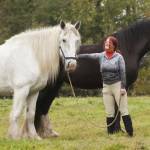Body Condition Index: New Tool for Objectively Assessing Body Fat in Horses

A new tool, called the body condition index (BCI), provides more consistent and repeatable measures of percent body fat than traditional body condition scoring (BCS). The BCI seems particularly suited to all horse owners, even inexperienced ones.
Currently, BCS is a widely recommended tool for assessing body fat (adiposity) in horses. The Henneke scale, one of the most widely used BCS systems, ranges from 1 to 9, with horses in moderate body condition designated a score of 5. Other BCS systems use a 0-5 scale.
“Body condition scoring is subjective, which means individuals assessing the same horse may assign different scores. Most evaluators correctly identify underweight horses, but differences are observed more frequently when assessing overweight or obese horses,” explained Catherine Whitehouse, M.S., a nutrition advisor for Kentucky Equine Research.
She added, “Owners may also be reluctant to admit their horse is overweight or in a state of positive energy balance. They then assign a lower BCS to fit into the generally accepted healthy range of 5 to 6.”
Further, studies reported that many horse owners find the BCS system too technical and have only a fair ability to judge BCS even after being given instructions.
“Considering how important it is for horses to maintain optimal body condition, reliable and accurate measures of adiposity are needed,” Whitehouse said.
Using mathematical methods and morphometric measurements, researchers developed a formula that correlates to percent body fat.* They called this the body condition index, which is based on measuring heart girth, belly girth, neck circumference, height, and body length.
In other words, the BCI measures the horse’s body circumference based on simple readings from a tape measure. This is in stark contrast to relying on vision or palpation when measuring BCS, which are highly subjective.
After developing the BCI, it was then applied to large numbers of horses and ponies by both trained and inexperienced evaluators and compared to the BCS.
The main finding was that the variability of these measurements by inexperienced assessors was higher (14%) for the BCS than the BCI (11%). This means that the BCI, as an objective measure of percent body fat, should be more consistent and reproducible when performed by horse owners.
“Having a more accurate assessment of adiposity is doubly important when we consider that many owners already underestimate their horses’ body condition and that subtle changes in condition over time can be challenging to identify,” Whitehouse said.
In sum, the researchers concluded that the BCI was more consistent and reliable than BCS, particularly for the inexperienced evaluators who were final-year veterinary students and therefore considered to have comparable skill to horse owners. “Using a BCI may be more beneficial and sensitive than BCS for tracking weight gain or weight loss,” relayed Whitehouse.
Recognizing that a horse is overweight will allow management strategies to be put in place to avoid obesity-related diseases such as equine metabolic syndrome, insulin dysregulation, and hyperinsulinemia-associated laminitis.
“The key to weight loss involves reducing caloric intake while providing a complete and balanced diet. Unrestricted pasture access is usually the main reason for weight gain, followed by high-calorie forages and feeds oversupplying calories based on the horse’s life stage or workload,” Whitehouse said. “Increasing exercise in sound horses in tandem with dietary changes can also induce weight loss.”
Whitehouse added, “Effective weight-loss programs combine strict dietary management with exercise, often utilizing a highly concentrated vitamin and mineral supplement to deliver key nutrients to support health and wellness in a low-calorie form.”
Check out Body Condition Resources for more information on weight management and body condition scoring.
*Potter, S.J., M.L. Erdody, N.J. Bamford, E.J. Knowles, N. Menzies-Gow, P.K. Morrison, C.M. Argo, B.J. McIntosh, K. Kaufman, P.A. Harris, and S.R. Bailey. Development of a body condition index to estimate adiposity in ponies and horses from morphometric measurements. Equine Veterinary Journal:13975.








